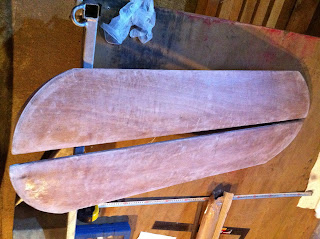I have started lengthening some of the stringer wood as all the lengths are around 5 metres, there are 7 full length stringers @ 6.5 metres per hull and then a further 3 per hull which stop at the aft end of the bunks @ 5.7 metres. I am adding 300mm to the stringers to allow for curves and clamping which may be required, so a total of 20, long pieces of wood need to be made.
Here is the basic method I am using to do the joints. Clamping 2 pieces together and cutting, then planing them on the same angle. Then the two paired pieces are glued together with epoxy glue being carefull to get them exactly straight. It is a fairly slow process but quite fun also.
Wednesday, 31 August 2011
Monday, 22 August 2011
Wood
I have been preparing wood for stringers. The wood is douglas fir and what you see here should be enough for the whole boat.
With another person helping it took a couple of hours to rip down from larger stock using a table saw. These lengths are a bit over 5 metres and will need scarphing to get the required 6.5 metre lengths and also planing. My garage now has a nice smell to it with all the freshly cut timber!
Monday, 15 August 2011
Rudders ready for paint.
Here are the rudders. Just about there. The photo angle is deceptive but the rudders really are exactly the same size!
I will probably leave painting them until I have the first hull ready for painting and do them at the same time. Meanwhile the rudders will be used as molds for the rudder housings which are next on my, to do list
I will probably leave painting them until I have the first hull ready for painting and do them at the same time. Meanwhile the rudders will be used as molds for the rudder housings which are next on my, to do list
Saturday, 6 August 2011
Rudders Part3
So the temperature finally got above 15 deg C so I could do some fibreglass sheathing.
I had shaped and sanded both rudders. But was unsure as to how exactly I could cover both sides at the same time, as I really did not want to do any overlapping seams or extra fairing so I used some screw hooks and hung the rudder from the ceiling as seen in the picture. I also used a 500W light to keep it warm.
I had shaped and sanded both rudders. But was unsure as to how exactly I could cover both sides at the same time, as I really did not want to do any overlapping seams or extra fairing so I used some screw hooks and hung the rudder from the ceiling as seen in the picture. I also used a 500W light to keep it warm.
I covered the rudders with two layers of 200 gsm cloth. As with all the sheathing used for the boat the primary function is to protect the wood from impact damage.
One down, one to go.
This was the first time I have done any fibreglass work myself, I learned a few things, it is not as easy as it looks, using fast hardener means you have to hurry to get the mixed epoxy onto the cloth, not much fun worrying about stuffing it up after all the work that has gone into the rudders so far.
Next step is to trim excess cloth and cover the ends and fair/sand etc.
Subscribe to:
Posts (Atom)








